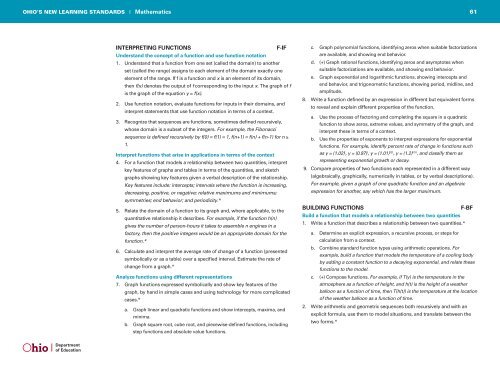Math-Standards.pdf
Math-Standards.pdf
Math-Standards.pdf
Create successful ePaper yourself
Turn your PDF publications into a flip-book with our unique Google optimized e-Paper software.
OHIO’S NEW LEARNING STANDARDS I <strong>Math</strong>ematics 61<br />
INTERPRETING FUNCTIONS<br />
F-IF<br />
Understand the concept of a function and use function notation<br />
1. Understand that a function from one set (called the domain) to another<br />
set (called the range) assigns to each element of the domain exactly one<br />
element of the range. If f is a function and x is an element of its domain,<br />
then f(x) denotes the output of f corresponding to the input x. The graph of f<br />
is the graph of the equation y = f(x).<br />
2. Use function notation, evaluate functions for inputs in their domains, and<br />
interpret statements that use function notation in terms of a context.<br />
3. Recognize that sequences are functions, sometimes defined recursively,<br />
whose domain is a subset of the integers. For example, the Fibonacci<br />
sequence is defined recursively by f(0) = f(1) = 1, f(n+1) = f(n) + f(n-1) for n ≥<br />
1.<br />
Interpret functions that arise in applications in terms of the context<br />
4. For a function that models a relationship between two quantities, interpret<br />
key features of graphs and tables in terms of the quantities, and sketch<br />
graphs showing key features given a verbal description of the relationship.<br />
Key features include: intercepts; intervals where the function is increasing,<br />
decreasing, positive, or negative; relative maximums and minimums;<br />
symmetries; end behavior; and periodicity.*<br />
5. Relate the domain of a function to its graph and, where applicable, to the<br />
quantitative relationship it describes. For example, if the function h(n)<br />
gives the number of person-hours it takes to assemble n engines in a<br />
factory, then the positive integers would be an appropriate domain for the<br />
function.*<br />
6. Calculate and interpret the average rate of change of a function (presented<br />
symbolically or as a table) over a specified interval. Estimate the rate of<br />
change from a graph.*<br />
Analyze functions using different representations<br />
7. Graph functions expressed symbolically and show key features of the<br />
graph, by hand in simple cases and using technology for more complicated<br />
cases.*<br />
a. Graph linear and quadratic functions and show intercepts, maxima, and<br />
minima.<br />
b. Graph square root, cube root, and piecewise-defined functions, including<br />
step functions and absolute value functions.<br />
c. Graph polynomial functions, identifying zeros when suitable factorizations<br />
are available, and showing end behavior.<br />
d. (+) Graph rational functions, identifying zeros and asymptotes when<br />
suitable factorizations are available, and showing end behavior.<br />
e. Graph exponential and logarithmic functions, showing intercepts and<br />
end behavior, and trigonometric functions, showing period, midline, and<br />
amplitude.<br />
8. Write a function defined by an expression in different but equivalent forms<br />
to reveal and explain different properties of the function.<br />
a. Use the process of factoring and completing the square in a quadratic<br />
function to show zeros, extreme values, and symmetry of the graph, and<br />
interpret these in terms of a context.<br />
b. Use the properties of exponents to interpret expressions for exponential<br />
functions. For example, identify percent rate of change in functions such<br />
as y = (1.02) t , y = (0.97) t , y = (1.01) 12t , y = (1.2) t/10 , and classify them as<br />
representing exponential growth or decay.<br />
9. Compare properties of two functions each represented in a different way<br />
(algebraically, graphically, numerically in tables, or by verbal descriptions).<br />
For example, given a graph of one quadratic function and an algebraic<br />
expression for another, say which has the larger maximum.<br />
BUILDING FUNCTIONS<br />
F-BF<br />
Build a function that models a relationship between two quantities<br />
1. Write a function that describes a relationship between two quantities.*<br />
a. Determine an explicit expression, a recursive process, or steps for<br />
calculation from a context.<br />
b. Combine standard function types using arithmetic operations. For<br />
example, build a function that models the temperature of a cooling body<br />
by adding a constant function to a decaying exponential, and relate these<br />
functions to the model.<br />
c. (+) Compose functions. For example, if T(y) is the temperature in the<br />
atmosphere as a function of height, and h(t) is the height of a weather<br />
balloon as a function of time, then T(h(t)) is the temperature at the location<br />
of the weather balloon as a function of time.<br />
2. Write arithmetic and geometric sequences both recursively and with an<br />
explicit formula, use them to model situations, and translate between the<br />
two forms.*


